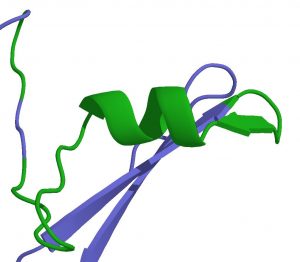
GHRP-2 and -6 are active in vivo through mimicking ghrelin (green). By own work - adapted from http://www.pdb.org/pdb/files/1p7x.pdb using PyMOL, Public Domain, https://commons.wikimedia.org/w/index.php?curid=4790168
Growth hormone releasing peptides (GHRPs) are relatively small molecules associated with the ability to affect the growth hormone secretagogue (GHS) system in some animals. Most GHRPs are made of six amino acids, and were developed with the goal of GHS enhancement and/or study. Their sequences are chosen for the ability to interact with the growth hormone secretagogue receptor (GHS-R) and to elicit some of the downstream effects of growth hormone release (e.g. increased IGF-1 levels). Therefore, either may be useful when applied to studies investigating the various potential roles of the GHS (also known as ghrelin) in mammalian systems. These are thought to include cardioprotection, the prevention of dysfunctional angiogenesis, the control of leptin signalling and cholesterol levels in circulation
1-3. GHRP-2 and GHRP-6 are two particularly well-studied synthetic GHS analogs. They are comparable in size (818 and 873Da respectively
i,ii). They are both available as high-quality research-grade compunds, available as lyophilized white solids
i,ii. Both peptides are associated with the classic effects of GHS-R activation (i.e. significant increases in GH and IGF-1 concentrations) and may also be associated with significant increases in GHS-R mRNA levels in cardiac tissues
4. They have similar sequences, but have structural differences
5. Both peptides have been found to act in tandem with GH-releasing factor (GRF or GHRH) to release GH from the rat pituitary
5. Both also have a lysine residue at the NH-terminal, although in the case of GHRP-6, this may be substituted for D-Lys, to generate an isoform that antagonizes the GHS-R
6. Therefore, GHRP-6 may have a greater range of application compared to GHRP-2.
Both peptides are thought to be associated with beneficial effects in response to events such as cardiac ischemia, as mentioned above. A study assessed this property using four GHRP variants, including GHRP-2 and (non-DLys) GHRP-6. These were administered subcutaneously to rats that underwent experimentally-induced chronic heart failure, and to identical control animals, at 100µg/kg twice daily for three weeks (or 100µg/kg saline as a placebo). Cardiomyocyte apoptosis (a marker of chronic heart failure) was significantly increased in placebo-treated animals compared to those treated with both GHRP-2 and GHRP-6
4. Treatment with both ghrelin mimetics also resulted in significant decreases in the stress-related hormones norepinephrine and renin compared to placebo-treated and control animals. GHRP-2 and -6 also had similar and significant effects on the levels of atrial natriuretic peptide, aldosterone and angiotensin-II compared to placebo-treated animals
4. The two peptides also exhibited significant decreases in the abnormal left ventricular dimensions associated with chronic heart failure when compared to that in placebo-treated animals
4. Treatment with both peptides also resulted in significantly improved ejection fractions compared to placebo
4. Both peptides were also associated with non-significant improvements in diastolic wall (albeit posterior only) thickness post-surgery compared to placebo-treated animals. Both peptides elicited similar effects on GH, IGF-1 and the GSH-R concentrations in experimental animals, as might be expected
4. These results indicate that GHRP-2 and -6 demonstrated similar abilities to improve cardiac function by significantly reducing stress and cardiomyocyte death in a model of chronic heart failure. However, neither peptide was associated with significant heart wall remodeling, as may have been expected
4.
In conclusion, GHRP-2 and GHRP-6 may have similar effects in the main locations of the GHS-R, i.e. the pituitary and in cardiac tissues. However, GHRP-6 has greater flexibility in terms of structure and receptor-binding activity when compared to GHRP-2.
References:
- Berlanga J, Cibrian D, Guevara L, et al. Growth-hormone-releasing peptide 6 (GHRP6) prevents oxidant cytotoxicity and reduces myocardial necrosis in a model of acute myocardial infarction. Clinical science (London, England : 1979). 2007;112(4):241-250.
- Madhavadas S, Kutty BM, Subramanian S. Amyloid beta lowering and cognition enhancing effects of ghrelin receptor analog [D-Lys (3)] GHRP-6 in rat model of obesity. Indian journal of biochemistry & biophysics. 2014;51(4):257-262.
- Zaniolo K, Sapieha P, Shao Z, et al. Ghrelin modulates physiologic and pathologic retinal angiogenesis through GHSR-1a. Investigative ophthalmology & visual science. 2011;52(8):5376-5386.
- Xu XB, Pang JJ, Cao JM, et al. GH-releasing peptides improve cardiac dysfunction and cachexia and suppress stress-related hormones and cardiomyocyte apoptosis in rats with heart failure. American journal of physiology. Heart and circulatory physiology. 2005;289(4):H1643-1651.
- Cheng J, Wu TJ, Butler B, Cheng K. Growth hormone releasing peptides: a comparison of the growth hormone releasing activities of GHRP-2 and GHRP-6 in rat primary pituitary cells. Life sciences. 1997;60(16):1385-1392.
- Luque EM, Torres PJ, de Loredo N, et al. Role of ghrelin in fertilization, early embryo development, and implantation periods. Reproduction (Cambridge, England). 2014;148(2):159-167.
- GHRP-2 Product Page. Bluesky Peptides. 2016
- GHRP-6 Product Page. Bluesky Peptides. 2016



